Stress Concentration Analysis of the Corroded Steel Plate Strengthened with Carbon Fiber Reinforced Polymer (CFRP) Plates
Abstract
:1. Introduction
2. Experimental Procedure
2.1. Accelerated Corrosion Experiment
2.2. 3D Surface Profile Measurements
3. Experimental Results and Discussion
4. Finite Element Models of Corroded Steel Plate Strengthened with and without CFRP Plates
4.1. Mesh Generation
4.2. Material Properties
4.3. Boundary Condition and Load Application
4.4. Model Validation and Mesh Convergence Analysis
5. Parameter Analysis
5.1. Effect of Corrosion Duration
5.2. Effect of CFRP Strengthening Stiffness
5.3. Effect of Adhesive Thickness
5.4. Effect of Prestress Level of CFRP Plates
6. Conclusions
- (1)
- The roughness of the corroded steel plates was characterized by the 3D roughness parameters Sa, Sq, and Sz. Local pitting corrosion and uniform corrosion alternately played the dominant role in the surface topography and roughness of the steel substrates, resulting in the fluctuating variation process of Sa, Sq, and Sz. Nevertheless, the values of Sa, Sq, and Sz of the corroded steel plates were much greater than that of the uncorroded ones.
- (2)
- The features of stress distribution and stress concentration factor Kt of the corroded steel plate strengthened with and without CFRP plates are only related to the shape, size, and position of the rust pits on the surface of the corroded steel plate, but not to the degree of uniform corrosion of the corroded steel plate, nor the thickness of the adhesive layer, the strengthening stiffness and prestress level of the CFRP plates, or other reinforcement parameters. The value of Kt for the corroded steel plate with a corrosion duration of 6~18 months and a weight loss rate of 9.16~21.78% is approximately 1.199~1.345.
- (3)
- The converted stress concentration factor Ktg, which is defined as the ratio of the peak stress at the rust pits on the surface of the corroded steel plate to the gross stress of the unpatched, uncorroded steel plate, has more practical significance than the stress concentration factor Kt in describing the influence of corrosion (negative part) and CFRP plate reinforcement (positive part) on the peak tensile stress of the corroded steel plate strengthened with CFRP plates. The value of Ktg increases linearly with the increase in the weight loss rate of the corroded steel plate and decreases appreciably with the increase in the strengthening stiffness and prestress level of the CFRP plates, and it presents a very small increasing trend with the increase in adhesive thickness.
Author Contributions
Funding
Institutional Review Board Statement
Informed Consent Statement
Data Availability Statement
Conflicts of Interest
References
- Wang, H.; Xu, S.; Li, A.; Kang, K. Experimental and numerical investigation on seismic performance of corroded welded steel con-nections. Eng. Struct. 2018, 174, 10–25. [Google Scholar] [CrossRef]
- Jia, C.; Shao, Y.; Guo, L.; Huang, H. Surface topography and stress concentration analysis for corroded high strength steel plate. J. Constr. Steel Res. 2021, 187, 106952. [Google Scholar] [CrossRef]
- Xu, S.; Wang, Y. Estimating the effects of corrosion pits on the fatigue life of steel plate based on the 3D profile. Int. J. Fatigue 2015, 72, 27–41. [Google Scholar] [CrossRef]
- Kodvanj, J.; Garbatov, Y.; Soares, C.G.; Parunov, J. Numerical analysis of stress concentration in non-uniformly corroded small-scale specimens. J. Mar. Sci. Appl. 2020, 20, 1–9. [Google Scholar] [CrossRef]
- Li, C.; Yin, X.; Wang, Y.; Zhang, L.; Zhang, Z.; Liu, Y.; Xian, G. Mechanical property evolution and service life prediction of pultruded carbon/glass hybrid rod exposed in harsh oil-well condition. Compos. Struct. 2020, 246, 112418. [Google Scholar] [CrossRef]
- Guo, R.; Xian, G.; Li, C.; Huang, X.; Xin, M. Effect of fiber hybridization types on the mechanical properties of carbon/glass fiber reinforced polymer composite rod. Mech. Adv. Mater. Struct. 2021, 1–13. [Google Scholar] [CrossRef]
- Lu, Y.; Li, W.; Li, S.; Li, X.; Zhu, T. Study of the Tensile Properties of CFRP Strengthened Steel Plates. Polymers 2015, 7, 2595–2610. [Google Scholar] [CrossRef]
- Wang, Y.; Zheng, Y.; Li, J.; Zhang, L.; Deng, J. Experimental study on tensile behaviour of steel plates with centre hole strengthened by CFRP plates under marine environment. Int. J. Adhes. Adhes. 2018, 84, 18–26. [Google Scholar] [CrossRef]
- Linghoff, D.; Al-Emrani, M. Performance of steel beams strengthened with CFRP laminate—Part 2: FE analyses. Compos. Part B-Eng. 2010, 41, 516–522. [Google Scholar] [CrossRef]
- Lenwari, A.; Thepchatri, T.; Albrecht, P. Flexural response of steel beams strengthened with partial-length CFRP plates. J. Compos. Constr. 2005, 9, 296–303. [Google Scholar] [CrossRef]
- Emdad, R.L.; Al-Mahaidi, R. Effect of prestressed CFRP patches on crack growth of centre-notched steel plates. Compos. Struct. 2015, 123, 109–122. [Google Scholar] [CrossRef]
- Huawen, Y.; König, C.; Ummenhofer, T.; Shizhong, Q.; Plum, R. Fatigue performance of tension steel plates strengthened with prestressed CFRP laminates. J. Compos. Constr. 2010, 14, 609–615. [Google Scholar] [CrossRef]
- Tavakkolizadeh, M.; Saadatmanesh, H. Fatigue strength of steel girders strengthened with carbon fiber rein-forced polymer patch. J. Struct. Eng. 2003, 129, 186–196. [Google Scholar] [CrossRef]
- Ghafoori, E.; Motavalli, M.; Botsis, J.; Herwig, A.; Galli, M. Fatigue strengthening of damaged metallic beams using prestressed unbonded and bonded CFRP plates. Int. J. Fatigue 2012, 44, 303–315. [Google Scholar] [CrossRef]
- Xiao, Z.G.; Zhao, X.L. CFRP repaired welded thin-walled cross-beam connections subject to in-plane fatigue loading. Int. J. Struct. Stab. Dyn. 2012, 12, 195–211. [Google Scholar] [CrossRef]
- Wang, Z.Y.; Wang, Q.Y. Fatigue strength of CFRP strengthened welded joints with corrugated steel plates. Compos. Part B-Eng. 2015, 72, 30–39. [Google Scholar] [CrossRef]
- Shaat, A.; Fam, A.Z. Slender steel columns strengthened using high-modulus CFRP plates for buckling control. J. Compos. Constr. 2009, 13, 2–12. [Google Scholar] [CrossRef]
- Gao, X.Y.; Balendra, T.; Koh, C.G. Buckling strength of slender circular tubular steel braces strengthened by CFRP. Eng. Struct. 2013, 46, 547–556. [Google Scholar] [CrossRef]
- Bambach, M.R.; Elchalakani, M. Plastic mechanism analysis of steel SHS strengthened with CFRP under large axial deformation. Thin-Walled Struct. 2007, 45, 159–170. [Google Scholar] [CrossRef]
- Haedir, J.; Zhao, X.L. Design of short CFRP-reinforced steel tubular columns. J. Constr. Steel Res. 2011, 67, 497–509. [Google Scholar] [CrossRef]
- Zhao, X.-L.; Zhang, L. State-of-the-art review on FRP strengthened steel structures. Eng. Struct. 2007, 29, 1808–1823. [Google Scholar] [CrossRef]
- Teng, J.G.; Yu, T.; Fernando, D. Strengthening of steel structures with fiber-reinforced polymer composites. J. Constr. Steel Res. 2012, 78, 131–143. [Google Scholar] [CrossRef]
- Wang, Z.; Li, C.; Sui, L.; Xian, G. Effects of adhesive property and thickness on the bond performance between carbon fiber reinforced polymer laminate and steel. Thin-Walled Struct. 2021, 158, 107176. [Google Scholar] [CrossRef]
- Chotickai, P. Effect of pre-installed corrosion on steel plate-CFRP bond characteristics. Int. J. Adhes. Adhes. 2018, 84, 431–437. [Google Scholar] [CrossRef]
- Li, A.; Wang, H.; Li, H.; Kong, D.; Xu, S. Estimation of bond strength and effective bond length for the double strap joint between carbon fiber reinforced polymer (CFRP) plate and corroded steel plate. Polymers 2022, 14, 3069. [Google Scholar] [CrossRef] [PubMed]
- Li, A.; Xu, S.; Wang, H.; Zhang, H.; Wang, Y. Bond behaviour between CFRP plates and corroded steel plates. Compos. Struct. 2019, 220, 221–235. [Google Scholar] [CrossRef]
- Xu, S.; Li, H.; Wang, Y.; Wang, Y.; Wang, Y. Influence of corrosion on the bond behavior in CFRP-steel single lap joints. Constr. Build. Mater. 2020, 236, 117607. [Google Scholar] [CrossRef]
- Sharaf, T.; Hosny, S.; Sasaki, E.; Ibrahim, M.G. Experimental and numerical analysis of the behavior of corroded steel plates strength-ened with thin-ply glass/carbon hybrid FRP composites. Ain Shams Eng. J. 2022, 13, 101557. [Google Scholar] [CrossRef]
- Elchalakani, M. Rehabilitation of corroded steel CHS under combined bending and bearing using CFRP. J. Constr. Steel Res. 2016, 125, 26–42. [Google Scholar] [CrossRef]
- Elchalakani, M.; Karrech, A.; Basarir, H.; Hassanein, M.; Fawzia, S. CFRP strengthening and rehabilitation of corroded steel pipelines under direct indentation. Thin-Walled Struct. 2017, 119, 510–521. [Google Scholar] [CrossRef] [Green Version]
- Yousefi, O.; Narmashiri, K.; Hedayat, A.A.; Karbakhsh, A. Strengthening of corroded steel CHS columns under axial compressive loads using CFRP. J. Constr. Steel Res. 2021, 178, 106496. [Google Scholar] [CrossRef]
- Li, A.; Xu, S.; Wang, Y.; Wu, C.; Nie, B. Fatigue behavior of corroded steel plates strengthened with CFRP plates. Constr. Build. Mater. 2022, 314, 125707. [Google Scholar] [CrossRef]
- Schijve, J. Fatigue of Structures and Materials, 2nd ed.; Springer: Delf, The Netherlands, 2009; pp. 13–21. [Google Scholar]
- Anbang, L. Fatigue Behavior and Design Method of Corroded Steel Plate Strengthened with CFRP Plates. Ph.D. Thesis, Xi’an University of Architecture & Technology, Xi’an, China, 2020. [Google Scholar]
- Wang, Z.-Y.; Wang, Q.-Y.; Li, L.; Zhang, N. Fatigue behaviour of CFRP strengthened open-hole steel plates. Thin-Walled Struct. 2017, 115, 176–187. [Google Scholar] [CrossRef]
- Wu, X.; Lin, B.; Cheng, J.; Wang, S. Cracked steel plates repaired by stop holes and CFRP and fatigue life prediction. J. Tianjin Univ. 2017, 50, 154–158. [Google Scholar]
- GB/T 24517-2009; Corrosion of Metals and Alloys, Outdoors Exposure Test Methods for Periodic Water Spray. Standards Press of China: Beijing, China, 2009.
- GB/T 10125-2012; Corrosion Tests in Artificial Atmospheres—Salt Spray Tests. Standards Press of China: Beijing, China, 2012.
- ISO 25178-2; Geometrical Product Specifications (GPS)—Surface Texture: Areal—Part 2: Terms, Definitions and Surface Texture Parameters. International Organization of Standardization: Geneva, Switzerland, 2012.
- Sun, C.T.; Klug, J.; Arendt, C. Analysis of cracked aluminum plates repaired with bonded composite patches. AIAA J. 1996, 34, 369–374. [Google Scholar] [CrossRef]
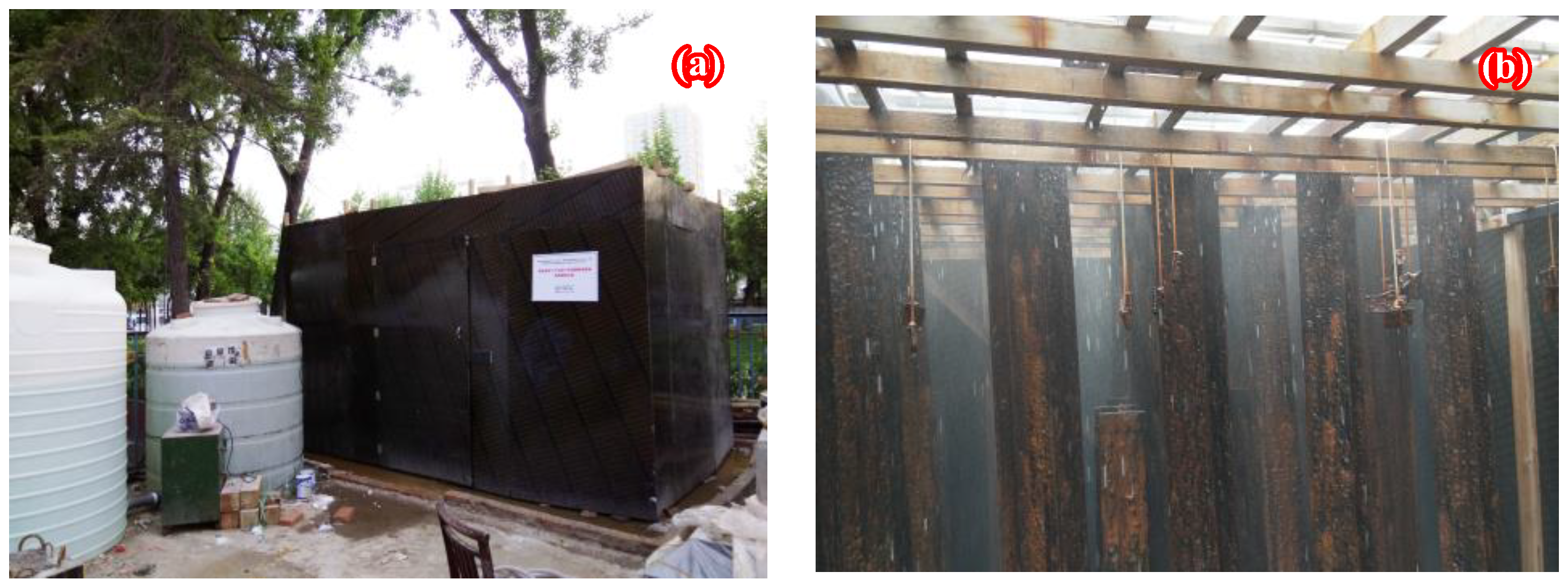
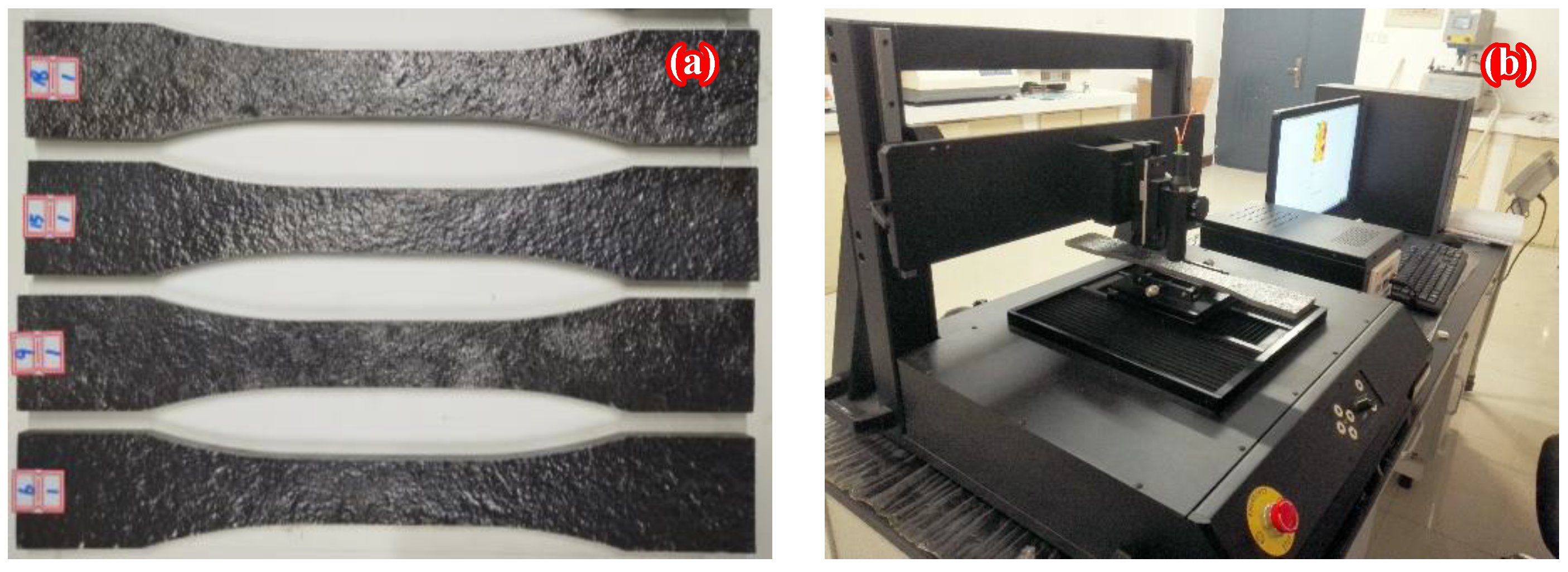

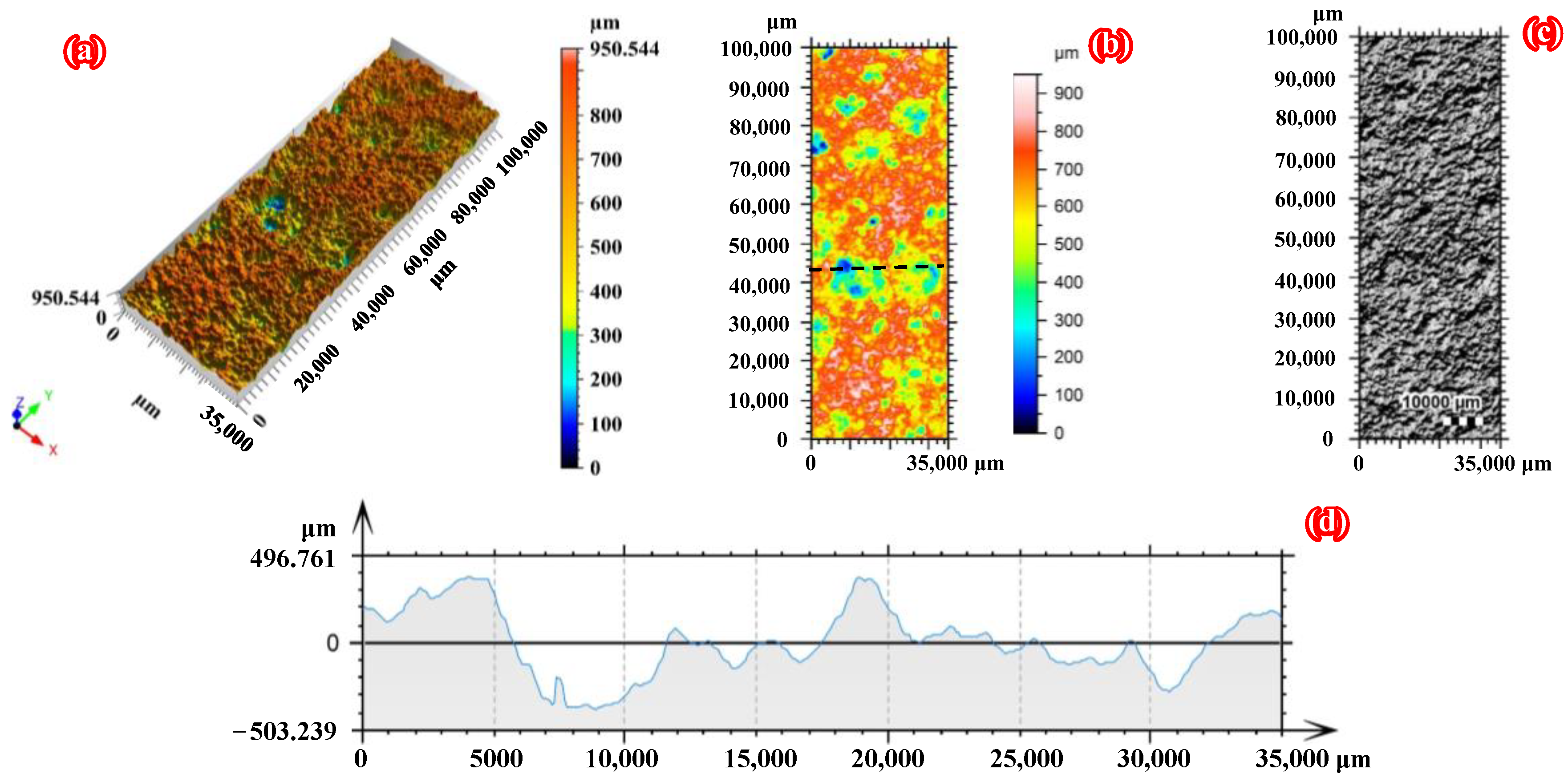
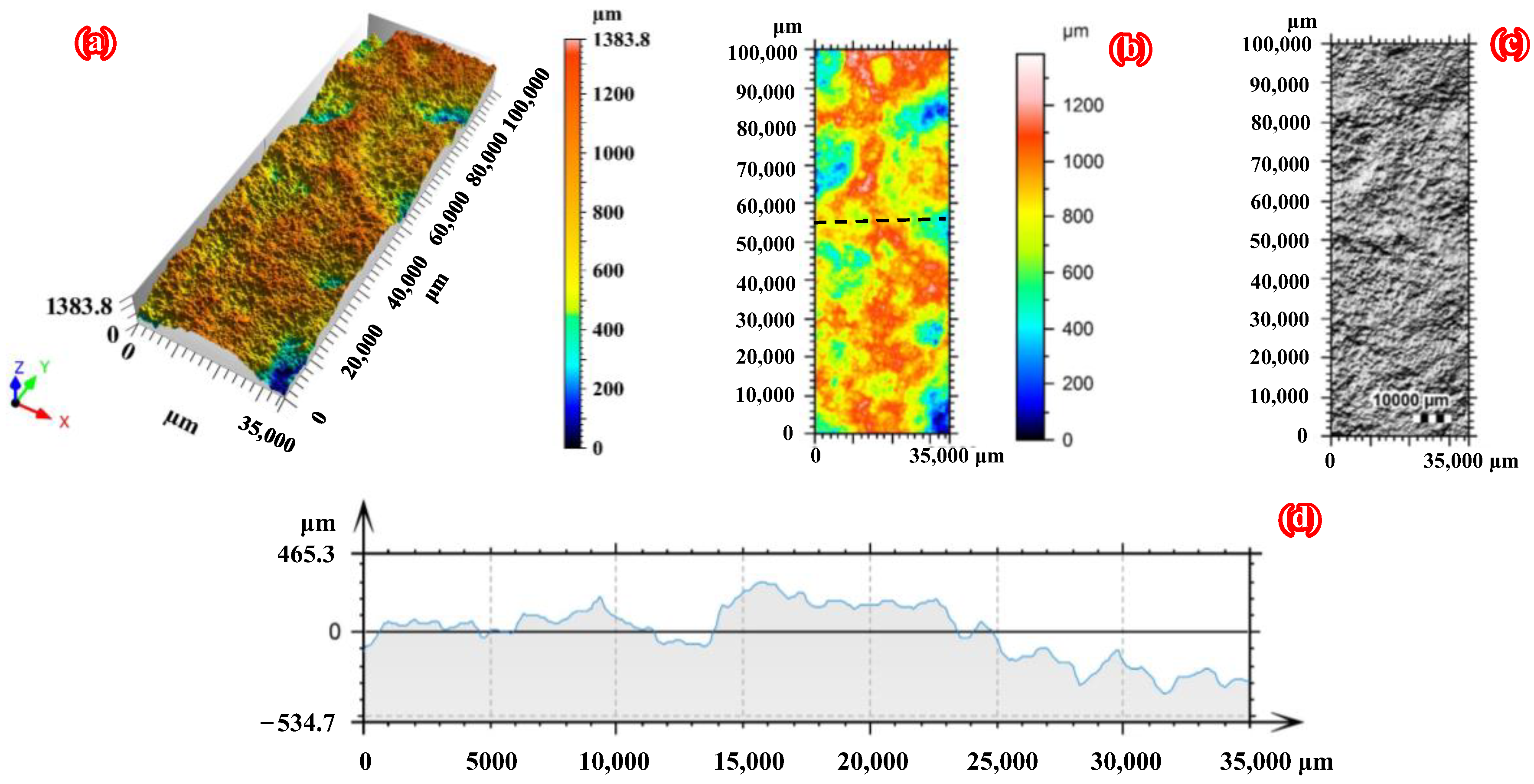

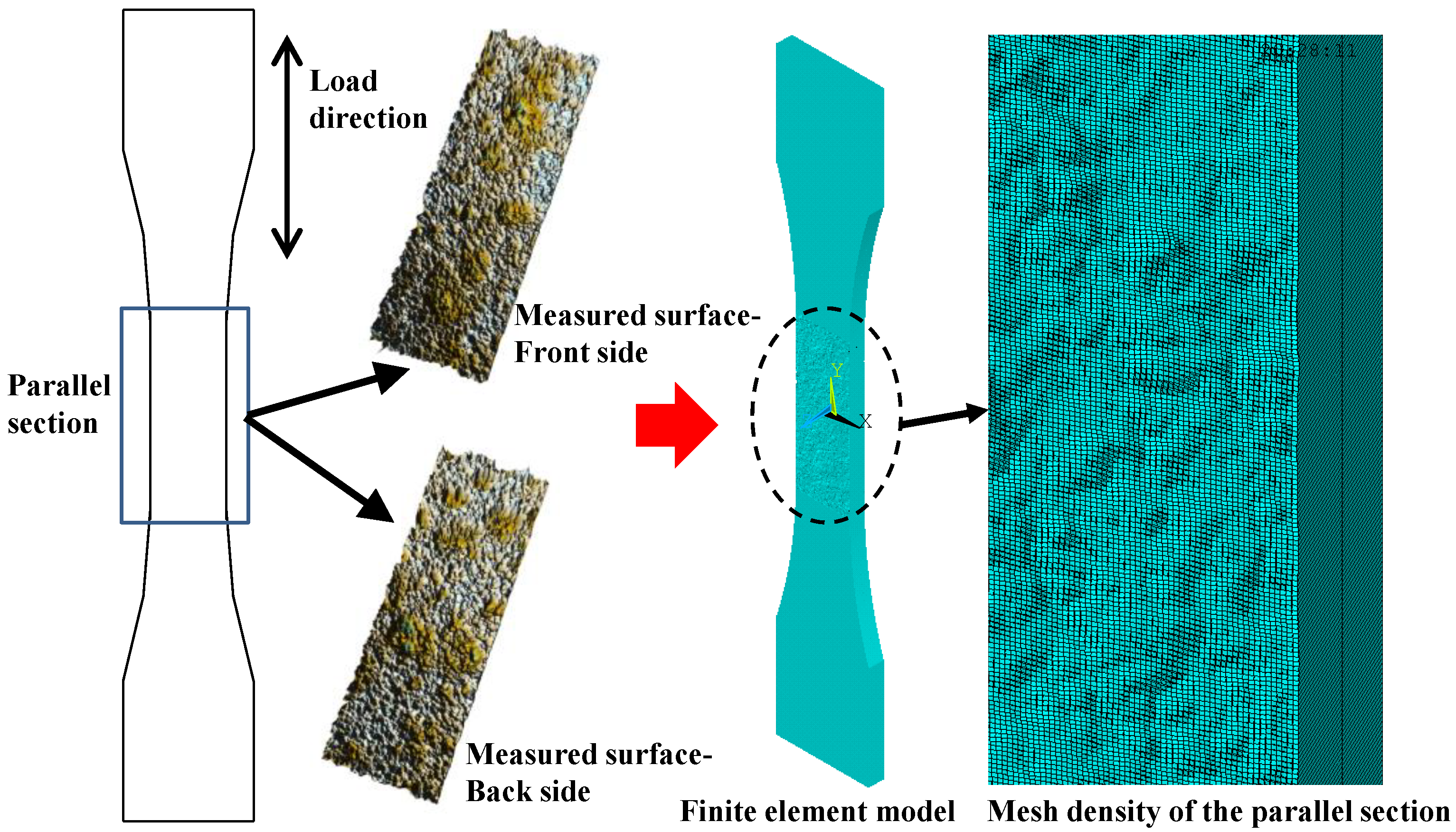
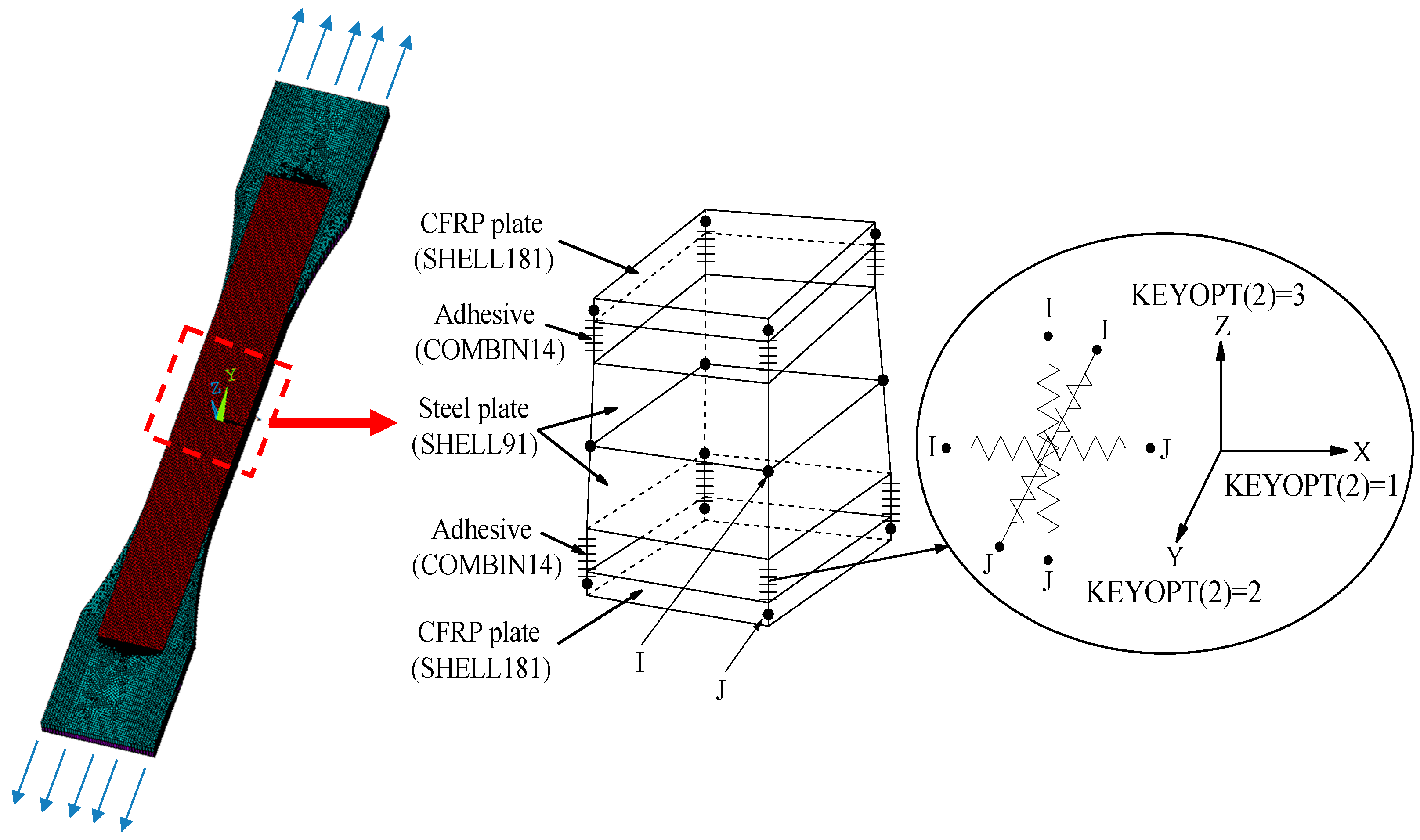


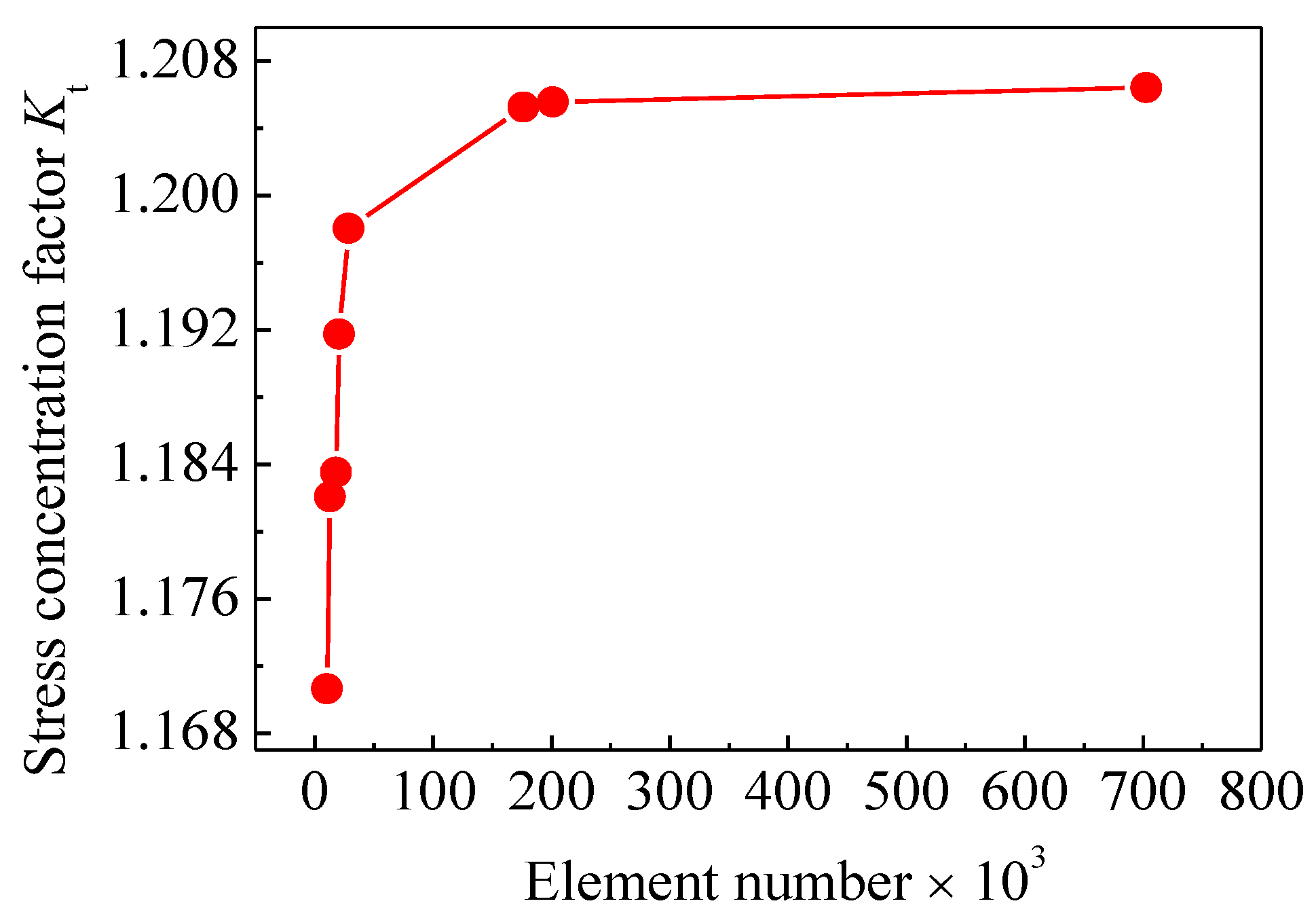

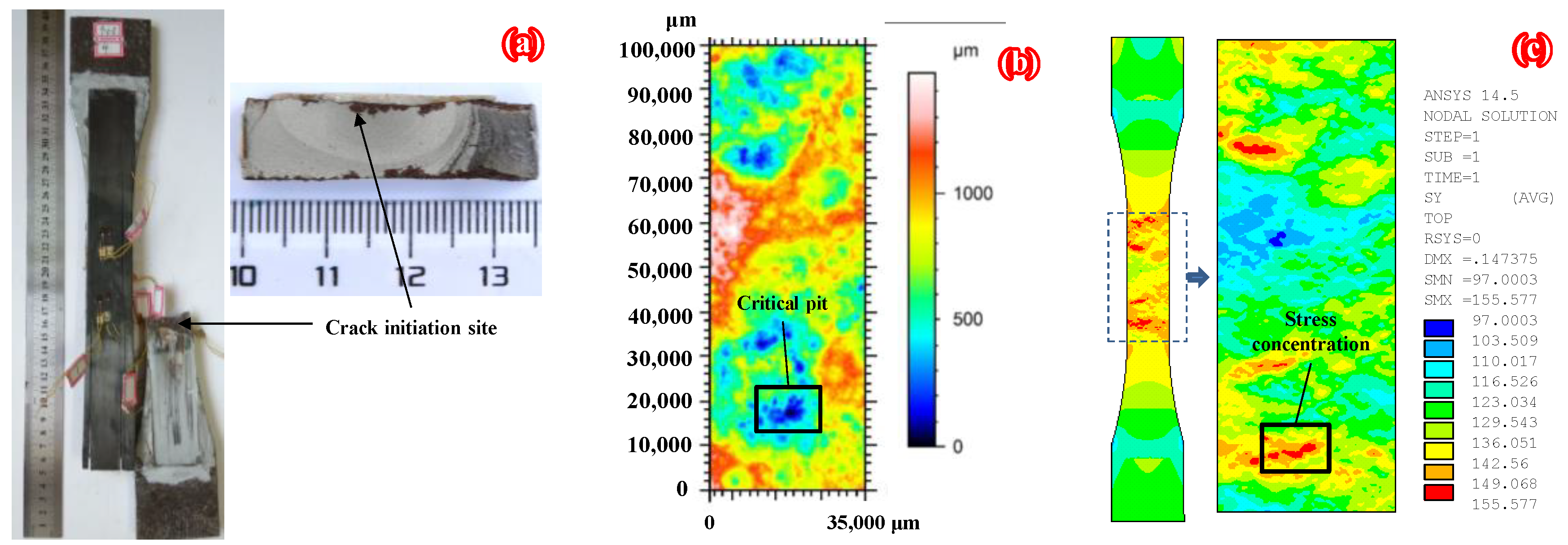
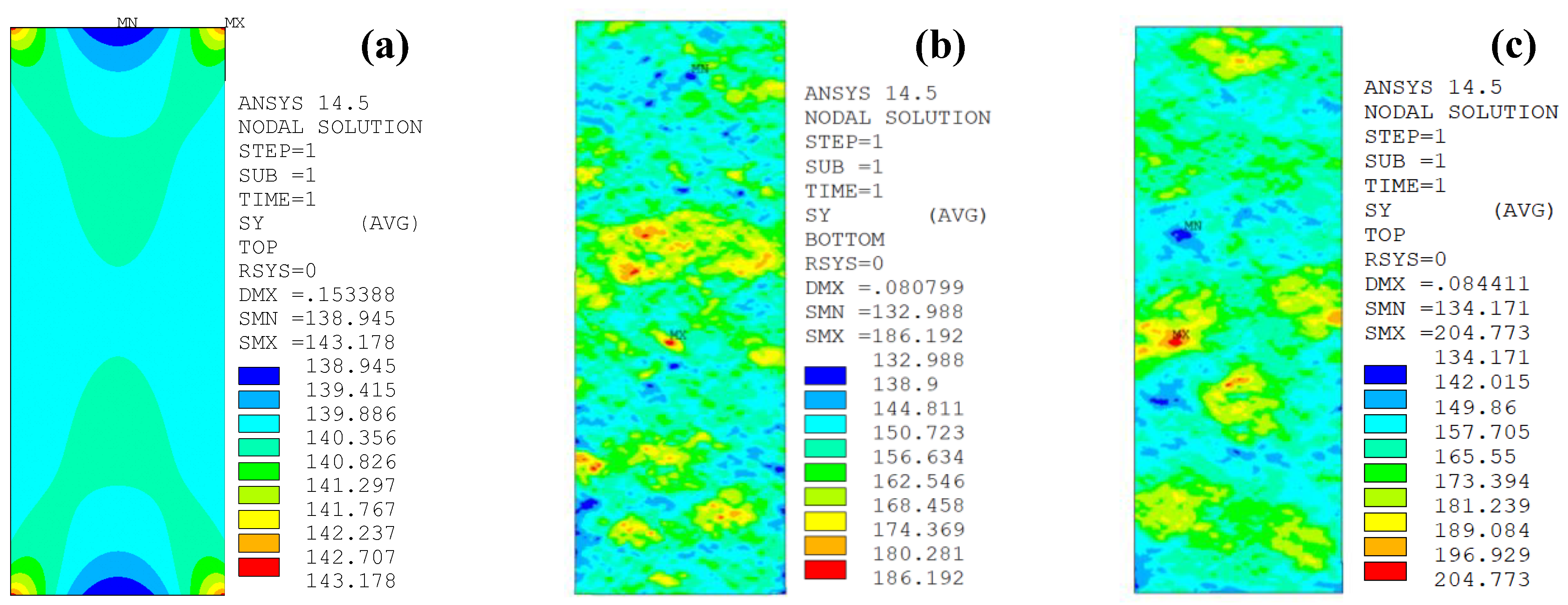


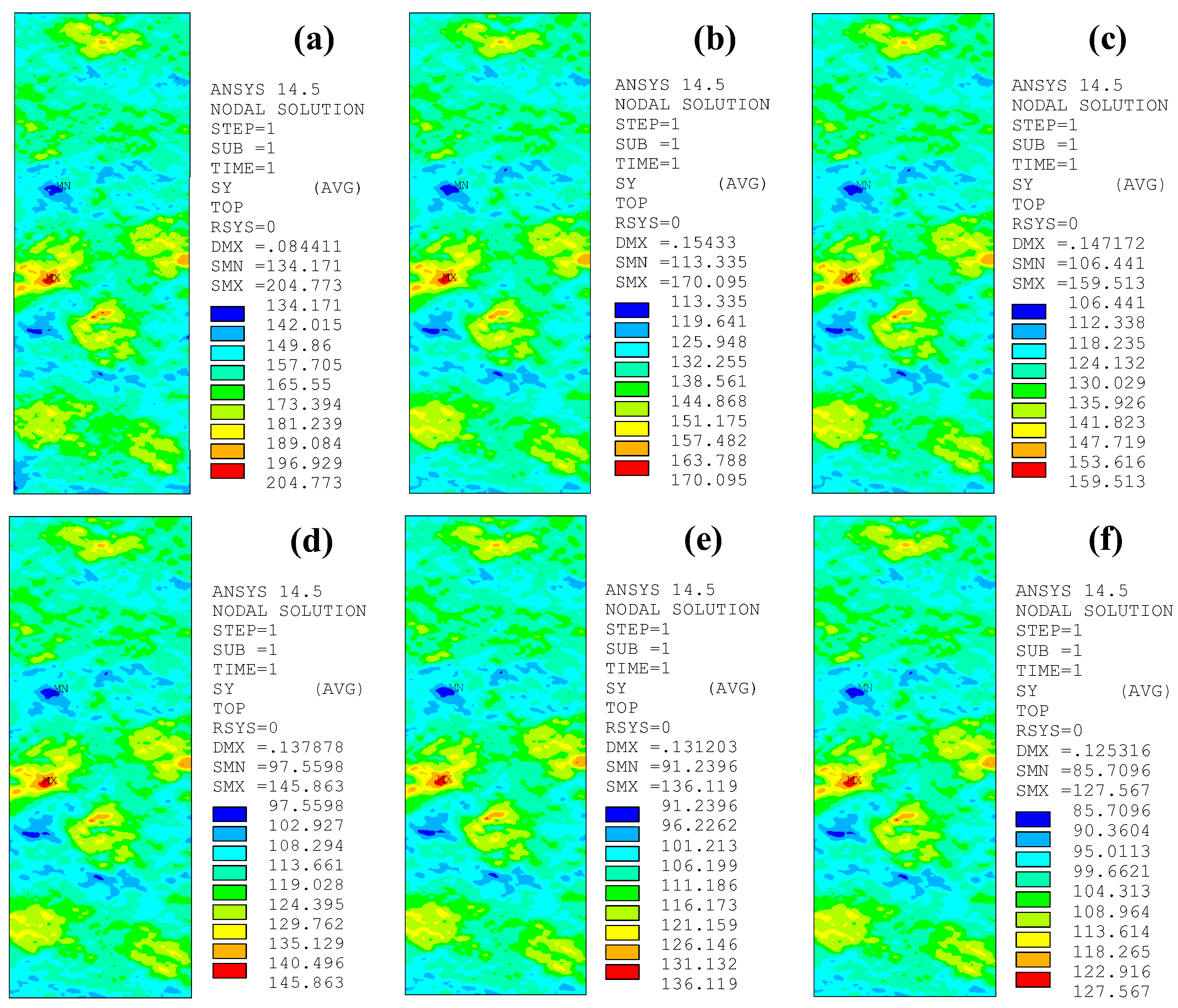
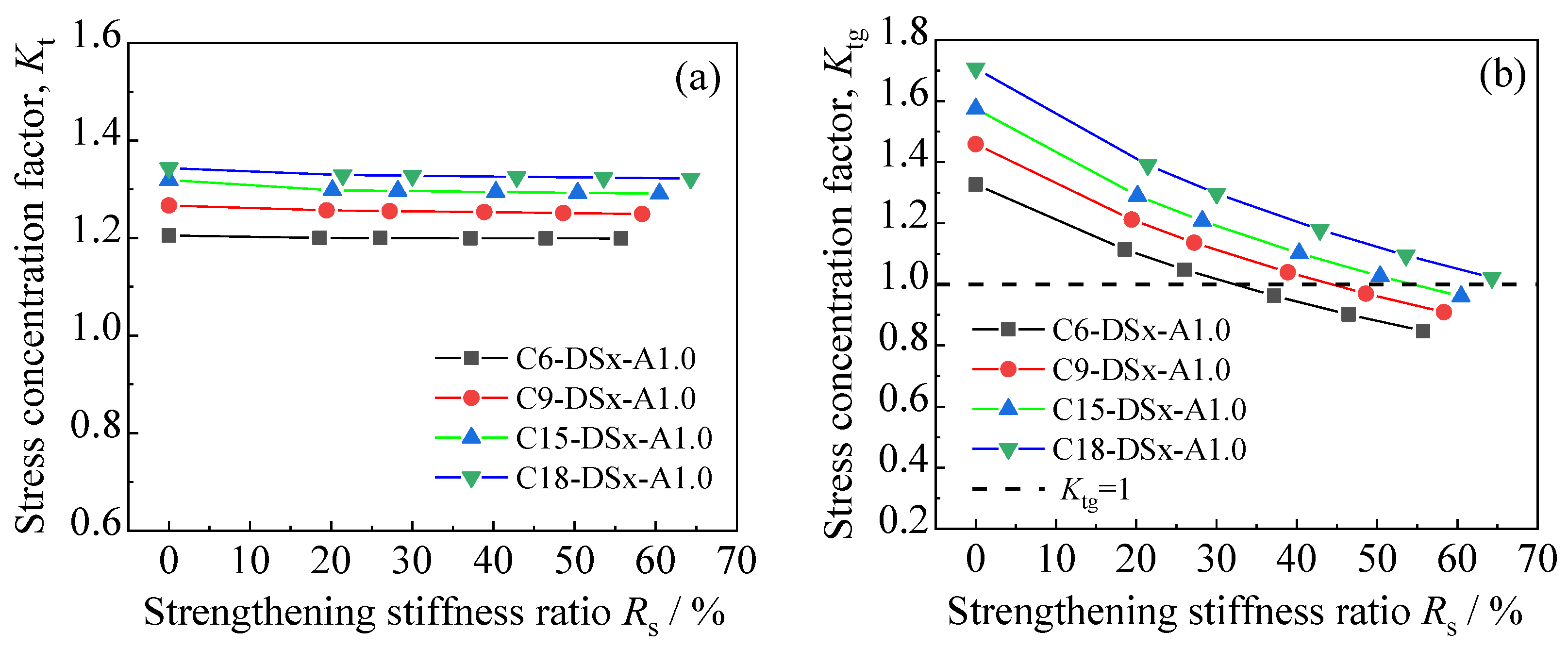




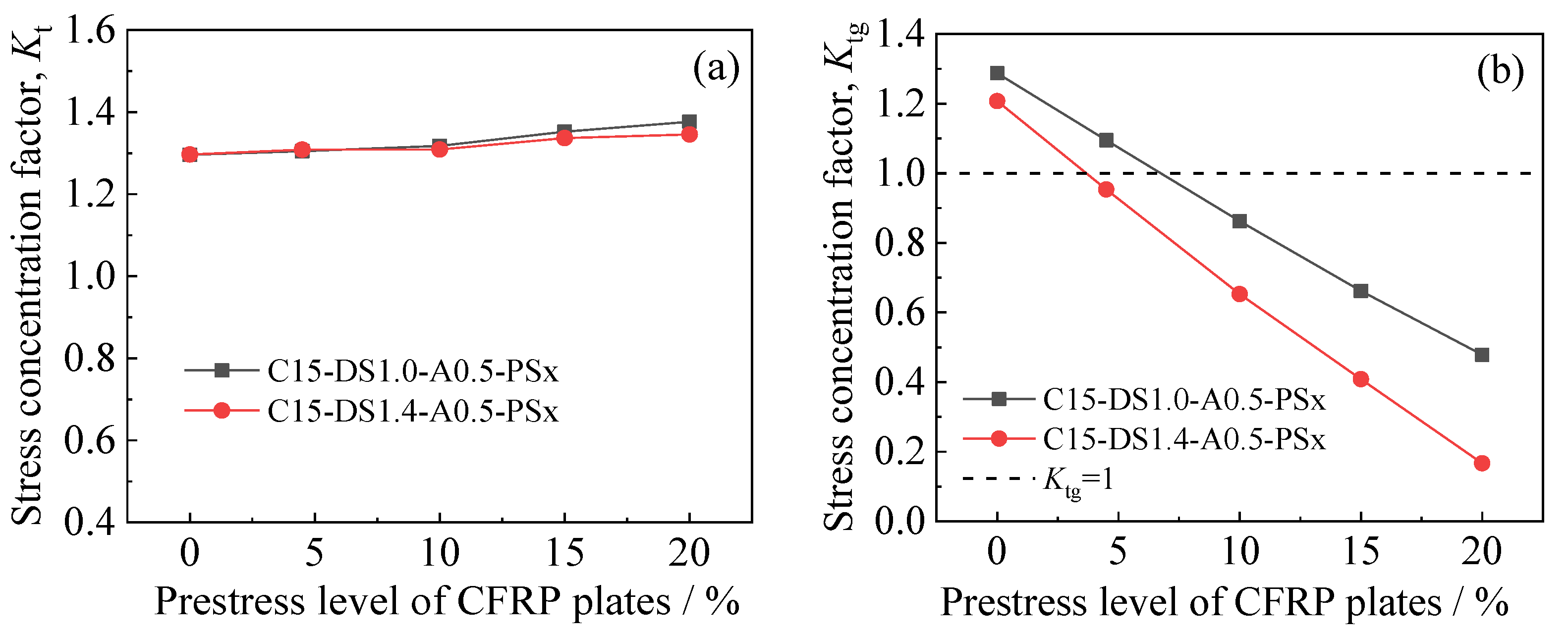
| Specimen No. | Cd /Month | ξ/ % | Sa /um | Sq /um | Sz /um | /MPa | /MPa | Kt | Ktg |
|---|---|---|---|---|---|---|---|---|---|
| C0-1 | 0 | 0 | 15.87 | 20.37 | 206.36 | 143.178 | 140.332 | 1.020 | 1.020 |
| C0-2 | 0 | 0 | 25.70 | 32.34 | 236.82 | 143.178 | 140.332 | 1.020 | 1.020 |
| C0-3 | 0 | 0 | 18.19 | 23.58 | 167.67 | 143.178 | 140.332 | 1.020 | 1.020 |
| C6-1 | 6 | 9.16 | 106.80 | 135.83 | 1130.96 | 186.192 | 154.483 | 1.205 | 1.327 |
| C6-2 | 6 | 9.59 | 114.40 | 146.50 | 983.09 | 191.513 | 155.218 | 1.234 | 1.365 |
| C6-3 | 6 | 12.02 | 102.48 | 133.12 | 1452.25 | 204.863 | 159.505 | 1.284 | 1.460 |
| C9-1 | 9 | 13.19 | 133.44 | 169.29 | 1139.45 | 204.773 | 161.654 | 1.267 | 1.459 |
| C9-2 | 9 | 13.25 | 177.37 | 217.42 | 1306.58 | 201.470 | 161.766 | 1.245 | 1.436 |
| C9-3 | 9 | 13.54 | 139.36 | 176.69 | 1199.03 | 200.937 | 162.309 | 1.238 | 1.432 |
| C15-1 | 15 | 16.26 | 131.52 | 168.46 | 1372.92 | 221.016 | 167.581 | 1.319 | 1.575 |
| C15-2 | 15 | 16.42 | 136.70 | 165.30 | 1016.48 | 203.388 | 167.902 | 1.211 | 1.449 |
| C15-3 | 15 | 16.99 | 141.74 | 173.59 | 1103.79 | 211.497 | 169.055 | 1.251 | 1.507 |
| C18-1 | 18 | 21.28 | 133.00 | 174.71 | 1369.64 | 239.481 | 178.276 | 1.343 | 1.707 |
| C18-2 | 18 | 21.58 | 133.02 | 166.40 | 1016.48 | 216.714 | 178.940 | 1.211 | 1.544 |
| C18-3 | 18 | 21.78 | 162.38 | 211.22 | 1429.16 | 239.180 | 179.407 | 1.333 | 1.704 |
| Specimen No. | Cd /Month | ξ /% | Rs /% | ta /mm | α/% | /MPa | Kt | Ktg | |
|---|---|---|---|---|---|---|---|---|---|
| C6-DS1.0-A0.5 | 6 | 9.16 | 18.58 | 0.5 | - | 156.300 | 130.280 | 1.200 | 1.114 |
| C6-DS1.0-A1.0 | 6 | 9.16 | 18.58 | 1.0 | - | 156.376 | 130.280 | 1.200 | 1.114 |
| C6-DS1.0-A1.5 | 6 | 9.16 | 18.58 | 1.5 | - | 156.415 | 130.280 | 1.201 | 1.115 |
| C6-DS1.0-A2.0 | 6 | 9.16 | 18.58 | 2.0 | - | 156.441 | 130.280 | 1.201 | 1.115 |
| C6-DS1.0-A2.5 | 6 | 9.16 | 18.58 | 2.5 | - | 156.462 | 130.280 | 1.201 | 1.115 |
| C6-DS1.4-A1.0 | 6 | 9.16 | 26.01 | 1.0 | - | 147.106 | 122.597 | 1.200 | 1.048 |
| C6-DS2.0-A1.0 | 6 | 9.16 | 37.16 | 1.0 | - | 135.106 | 112.633 | 1.200 | 0.963 |
| C6-DS2.5-A1.0 | 6 | 9.16 | 46.44 | 1.0 | - | 126.523 | 105.489 | 1.199 | 0.902 |
| C6-DS3.0-A1.0 | 6 | 9.16 | 55.73 | 1.0 | - | 118.961 | 99.197 | 1.199 | 0.848 |
| C9-DS1.0-A0.5 | 9 | 13.19 | 19.44 | 0.5 | - | 170.025 | 135.343 | 1.256 | 1.212 |
| C9-DS1.0-A1.0 | 9 | 13.19 | 19.44 | 1.0 | - | 170.095 | 135.343 | 1.257 | 1.212 |
| C9-DS1.0-A1.5 | 9 | 13.19 | 19.44 | 1.5 | - | 170.146 | 135.343 | 1.257 | 1.212 |
| C9-DS1.0-A2.0 | 9 | 13.19 | 19.44 | 2.0 | - | 170.186 | 135.343 | 1.257 | 1.213 |
| C9-DS1.0-A2.5 | 9 | 13.19 | 19.44 | 2.5 | - | 170.219 | 135.343 | 1.258 | 1.213 |
| C9-DS1.4-A1.0 | 9 | 13.19 | 27.22 | 1.0 | - | 159.513 | 127.070 | 1.255 | 1.137 |
| C9-DS2.0-A1.0 | 9 | 13.19 | 38.88 | 1.0 | - | 145.863 | 116.398 | 1.253 | 1.039 |
| C9-DS2.5-A1.0 | 9 | 13.19 | 48.60 | 1.0 | - | 136.119 | 108.784 | 1.251 | 0.970 |
| C9-DS3.0-A1.0 | 9 | 13.19 | 58.32 | 1.0 | - | 127.567 | 102.106 | 1.249 | 0.909 |
| C15-DS1.0-A0.5 | 15 | 16.26 | 20.15 | 0.5 | - | 180.700 | 139.473 | 1.296 | 1.288 |
| C15-DS1.0-A0.5-PS4.5 | 15 | 16.26 | 20.15 | 0.5 | 4.5 | 153.634 | 117.767 | 1.305 | 1.095 |
| C15-DS1.0-A0.5-PS10 | 15 | 16.26 | 20.15 | 0.5 | 10 | 121.004 | 91.839 | 1.318 | 0.862 |
| C15-DS1.0-A0.5-PS15 | 15 | 16.26 | 20.15 | 0.5 | 15 | 92.884 | 68.690 | 1.352 | 0.662 |
| C15-DS1.0-A0.5-PS20 | 15 | 16.26 | 20.15 | 0.5 | 20 | 67.156 | 48.800 | 1.376 | 0.479 |
| C15-DS1.0-A1.0 | 15 | 16.26 | 20.15 | 1.0 | - | 181.023 | 139.473 | 1.298 | 1.290 |
| C15-DS1.0-A1.5 | 15 | 16.26 | 20.15 | 1.5 | - | 181.193 | 139.473 | 1.299 | 1.291 |
| C15-DS1.0-A2.0 | 15 | 16.26 | 20.15 | 2.0 | - | 181.305 | 139.473 | 1.300 | 1.292 |
| C15-DS1.0-A2.5 | 15 | 16.26 | 20.15 | 2.5 | - | 181.387 | 139.473 | 1.301 | 1.293 |
| C15-DS1.4-A0.5-PS4.5 | 15 | 16.26 | 28.21 | 0.5 | 4.5 | 133.786 | 102.271 | 1.308 | 0.953 |
| C15-DS1.4-A0.5-PS10 | 15 | 16.26 | 28.21 | 0.5 | 10 | 91.627 | 70.023 | 1.309 | 0.653 |
| C15-DS1.4-A0.5-PS15 | 15 | 16.26 | 28.21 | 0.5 | 15 | 57.313 | 42.886 | 1.336 | 0.408 |
| C15-DS1.4-A0.5-PS20 | 15 | 16.26 | 28.21 | 0.5 | 20 | 23.377 | 17.377 | 1.345 | 0.167 |
| C15-DS1.4-A1.0 | 15 | 16.26 | 28.21 | 1.0 | - | 169.456 | 130.704 | 1.296 | 1.208 |
| C15-DS2.0-A1.0 | 15 | 16.26 | 40.31 | 1.0 | - | 154.607 | 119.440 | 1.294 | 1.102 |
| C15-DS2.5-A1.0 | 15 | 16.26 | 50.38 | 1.0 | - | 144.051 | 111.436 | 1.293 | 1.026 |
| C15-DS3.0-A1.0 | 15 | 16.26 | 60.46 | 1.0 | - | 134.811 | 104.438 | 1.291 | 0.961 |
| C18-DS1.0-A0.5 | 18 | 21.28 | 21.44 | 0.5 | - | 194.754 | 146.803 | 1.327 | 1.388 |
| C18-DS1.0-A1.0 | 18 | 21.28 | 21.44 | 1.0 | - | 195.123 | 146.803 | 1.329 | 1.390 |
| C18-DS1.0-A1.5 | 18 | 21.28 | 21.44 | 1.5 | - | 195.325 | 146.803 | 1.331 | 1.392 |
| C18-DS1.0-A2.0 | 18 | 21.28 | 21.44 | 2.0 | - | 195.458 | 146.803 | 1.331 | 1.393 |
| C18-DS1.0-A2.5 | 18 | 21.28 | 21.44 | 2.5 | - | 195.554 | 146.803 | 1.332 | 1.394 |
| C18-DS1.4-A1.0 | 18 | 21.28 | 30.01 | 1.0 | - | 182.043 | 137.120 | 1.328 | 1.297 |
| C18-DS2.0-A1.0 | 18 | 21.28 | 42.88 | 1.0 | - | 165.395 | 124.775 | 1.326 | 1.179 |
| C18-DS2.5-A1.0 | 18 | 21.28 | 53.60 | 1.0 | - | 153.655 | 116.067 | 1.324 | 1.095 |
| C18-DS3.0-A1.0 | 18 | 21.28 | 64.32 | 1.0 | - | 143.446 | 108.495 | 1.322 | 1.022 |
Publisher’s Note: MDPI stays neutral with regard to jurisdictional claims in published maps and institutional affiliations. |
© 2022 by the authors. Licensee MDPI, Basel, Switzerland. This article is an open access article distributed under the terms and conditions of the Creative Commons Attribution (CC BY) license (https://creativecommons.org/licenses/by/4.0/).
Share and Cite
Li, A.; Wang, H.; Li, H.; Kong, D.; Xu, S. Stress Concentration Analysis of the Corroded Steel Plate Strengthened with Carbon Fiber Reinforced Polymer (CFRP) Plates. Polymers 2022, 14, 3845. https://doi.org/10.3390/polym14183845
Li A, Wang H, Li H, Kong D, Xu S. Stress Concentration Analysis of the Corroded Steel Plate Strengthened with Carbon Fiber Reinforced Polymer (CFRP) Plates. Polymers. 2022; 14(18):3845. https://doi.org/10.3390/polym14183845
Chicago/Turabian StyleLi, Anbang, Hao Wang, Han Li, Deliang Kong, and Shanhua Xu. 2022. "Stress Concentration Analysis of the Corroded Steel Plate Strengthened with Carbon Fiber Reinforced Polymer (CFRP) Plates" Polymers 14, no. 18: 3845. https://doi.org/10.3390/polym14183845





